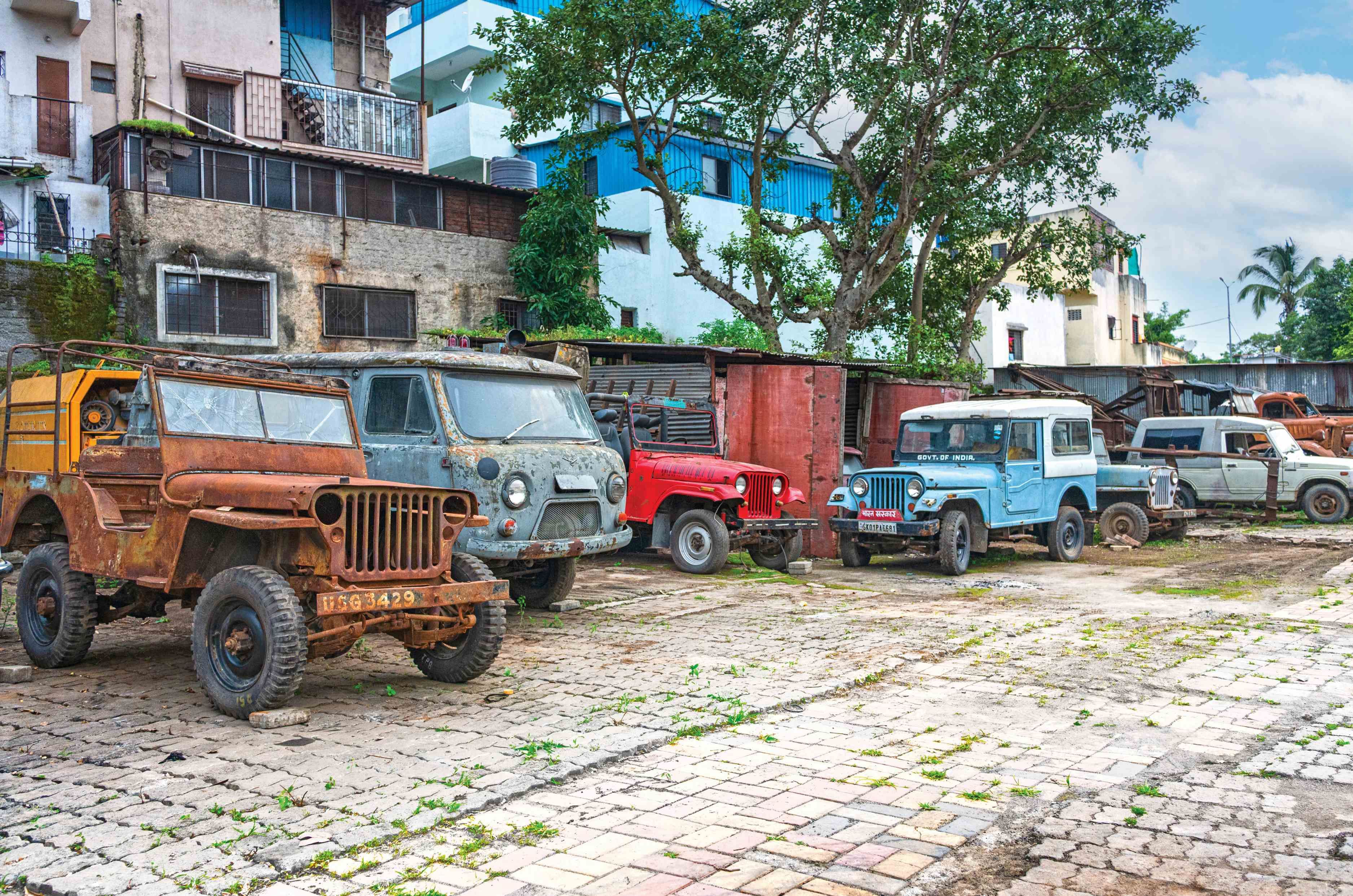
Nestled in a sleepy suburb of Pune – not too far from the airport – lies a gate that feels like a portal to another world. It’s unassuming – no grand pillars, no welcome sign, but step through, and SNAP, you’re teleported back in time to a military yard.
Crusted in rust, steeped in history and waiting their turn to be brought back to life – a collection of rare and historically significant off roaders that span decades. I initially walk around this barn just gaping in amazement. Yeah, sure, museums are dope, but collector Suhas Tingre’s yard is just so much more interactive. Can you beat lifting bonnets, identifying transfer cases and four-wheel-drive systems?
Origin of the species
 The sheer variety and number of 4x4s here is staggering – what a collection!
The sheer variety and number of 4x4s here is staggering – what a collection!
Set in between a handful of barns, there are off roaders here in all shapes and sizes. So where do we start? How about with the Willys MB and Ford GPW, the Bantam-designed off-roader that started it all. This is something that’s well documented here. Scattered in various places around the yard are up to seven low-bonnet Jeeps. The one I’m standing next to is a Ford GPW – distinguished by the flat cross member just behind (and inside) the grille, as against a rounded one for Willys’ MB. Remember, it was Willys who was first contracted to make the Jeep, and then Ford was added to the list when production had to be ramped up. Ford then modified many parts to make it easier for mass production. Built under license from Willys between 1941 and 1945, Ford manufactured roughly 2,77,000 GPWs during the war, with “GPW” standing for Government, 80-inch wheelbase (“P” in Army code), and W for Willys’ Go-Devil 60hp engine.
War trophies
 Series 2 Land Rover and Pakistan Army M38A1; note 2nd battery box.
Series 2 Land Rover and Pakistan Army M38A1; note 2nd battery box.
The military lineage continues with the green M38 Jeep. Based on the CJ2 with larger lights, the M38’s grille and windscreen have been replaced here. This updated military version was never officially imported into India. Under the skin, the front axle had been beefed up to take more load, and the engine bay was modified to allow for relatively unrestricted flow of water when driving semi submerged. Also present – a real gem – is the bright red M38A1, a military-spec Jeep that never officially came to India. Don’t be fooled by the bright red paint; the M38A1’s waterproof battery box, chassis-lifting hooks, and footman loops used for air and sea transport confirm its military pedigree. The pair of units here has a fascinating story. They were captured from the Pakistan Army during the 1971 war (probably 1965 for the M38) and brought into India as war trophies! Talk about provenance.
Local Heroes
Next up, locally made CJs, or Civilian Jeeps. What we are talking of here is the ubiquitous CJ3B, made, of course, by Mahindra. Several versions of this first high-bonnet Jeep are present in the yard – the higher bonnet utilised to help it clear various components of the taller 2,199cc F-head engine.

The most historically significant CJ3B is the one fitted with an RCL (Recoilless rifle) mount. Similar to the one used by quartermaster Abdul Hamid during the 1965 Battle of Asal Uttar, this one got a cutout in the windscreen for the rifle. Hamid famously knocked out between six and eight Pakistani Patton tanks and earned the Param Vir Chakra posthumously, with his CJ3B and the M40 105mm recoilless rifle also featured on a postal stamp. There are several other CJ3Bs here. Nearby, there’s an army-spec Jeep complete with blackout lights; there’s another one with a Willys badge being worked on with its blue patina nicely preserved.
Up next, another M38A1-based civilian Jeep; this particular model has been converted into an ambulance by Houston-based Koenig. It’s a rare civilian adaptation of a military workhorse.
Rusted but rare

Trundling further reveals a rare MM440 – a petrol-powered Jeep produced in India by Mahindra between 1966 and 1968, with fewer than 2,000 units made. Under its bonnet sits the Willys F-head engine. Look further, and you’ll see Mahindra’s Legend, made to commemorate 60 years of Mahindra’s CJ. And let’s not forget that the first-generation Thar was a CJ with an independent front suspension and was powered by the Scorpio’s common rail diesel engine. Talk about circularity.
Another bit of Indian military history is the Jonga – a Gen-2 Nissan Patrol by the Vehicle Factory Jabalpur. Sharing space with it are three Dodge WC-series weapon carriers – three-quarter-ton 4x4s designed to ferry armaments into battle.

Then there’s a short wheelbase Suzuki Samurai, with a bonnet borrowed from an Air Force Gypsy, a 1.0-litre engine and a unique hardtop featuring a Land Rover-like ‘skylight’. And we have a Land Rover too, what looks like an early Series II. And why was the Land Rover made in the first place? One of the engineers at Rover couldn’t find a replacement for his Jeep!
From Russia with love

Then there’s the solidly built UAZ-452, a Russian four-wheel-drive van used by the Indian Air Force for radar and missile systems. Nicknamed “Buhanka” or “loaf of bread” in Russia due to its shape, it’s a quirky yet capable off-roader that’s surprisingly practical. Up ahead, another UAZ, the 469, featured in Autocar India earlier, is here in completely original guise. Even the tyres are original!
Practical, tactical
No Jeep collection can be complete without the trailers, and there are over a dozen here. In fact, so many trough-shaped carriers originally built by Jeep, Mahindra and VFJ are a part of the collection that there’s a whole area reserved for them. The added practicality they provided was often invaluable. And there’s variety too; one artillery shell carrier features leaf-spring bumpers designed to absorb impact and protect its precious cargo. Another that’s even more fascinating is a mobile workshop trailer, fully equipped to support field repairs with compressors, lathes and lifts; a nod to the army’s ever-moving nature.
Heavy hitters

The yard also has more than a few military trucks. A Mack Thermodyne diesel truck, complete with the iconic bulldog hood ornament, is the most recent, and it looks like it can haul an 18-wheeler just about anywhere. How it came to be part of this collection is something of a mystery. Parked beside it is a Diamond T 6×6 wrecker, a wartime workhorse. With its massive winch and rugged double axle rear, these trucks were instrumental in building the Stillwell Road into China – a vital supply route during the war and used on USAAF airfields in the east of India, where transport aircraft like the C-47 Dakota and C46 Commando would be flying across the Himalayas, or the ‘Hump’ as the pilots called them. And finally, next to it are a pair of Dodge weapons carriers or WCs, an all-wheel-drive truck that was used to move all manner of US Army essentials. These ‘bigger Jeeps’ or ‘Beeps’ were the backbone of the US Army columns, and here, looking closely at their wood and metal loading bays feels like going through a time warp.
Offroad heaven

Stepping out of the yard, head spinning, I can all but line up the history of the 4×4 in my head. Where it all started, the evolution of that amazing design, and how it influenced other four-wheel-drive vehicles around the world; in many ways, the influencer! What a place.
Also See:

